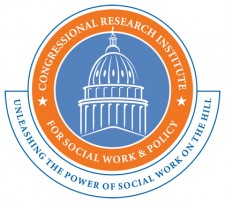Congresswoman Barbara Lee, chair of the Congressional Social Work Caucus joined several of her colleagues in forming the Full Employment Caucus last week. Led by the venerable Congressman John Conyers from Detroit, the Full Employment Caucus will focus its attention on developing ideas that will lead to accelerating employment opportunities for millions of Americans seeking work. “One of the primary vehicles and pathways out of poverty is a job,” said Rep. Barbara Lee. “That’s what people want. People don’t want to have to rely on food stamps, Section 8 or Medicaid. People want a job.” Others in the Full Employment Caucus are: Reps. Sheila Jackson Lee (TX-18), Mike Quiqley (IL-5), Maxine Waters (CA-35), Charles Rangel (NY-13), Frederica Wilson (FL-24), and José Serrano (NY-15).
Rep. Conyers says the caucus plans to host regular meetings with economists and policymakers to discuss proposals that will lead to job creation and strategies needed to implement the proposals. “Achieving full employment isn’t only about helping jobless people,” Conyers wrote in an op-ed piece in The Hill. “When we return to full employment, investors and businesspeople have more customers. When we return to full employment, workers have power to bargain for higher wages.” He has introduced H.R. 1000—The Humphrey-Hawkins 21st Century Full Employment and Training Act, a bill to create the National Full Employment Trust Fund that will provide grants to states, local governments and tribal communities. The bill follows the precedent of the Full Employment and Balanced Growth Act introduced in the House by California Rep. Augustus Hawkins and in the Senate by Minnesota Sen. Hubert Humphrey and signed into law by President Jimmy Carter in 1978. This bill amended The Employment Act signed into law by President Harry S. Truman in 1946.
At issue is what exactly is full employment and how much can the government do to achieve full employment? Full employment is a macroeconomic concept describing a condition whereby all those in a society able and willing to work can find employment at the prevailing wages or the level of employment that creates sufficient demand as to avoid cyclical unemployment and high levels of inflation. That means some level of unemployment above zero percent. Economists have differing views about what that level should be. There is a relative consensus that full employment in the United States is somewhere in the neighborhood of 5 percent. Economists rely on a concept of a “natural” unemployment rate introduced by James Tobin known as the Non-Accelerating Inflation Rate of Unemployment or NAIRU where real gross domestic product (GDP) equals potential output.
With the official unemployment rate falling to 6.7 percent in December, one would think that we are not far from full employment. However, the full employment rate must include the underemployed as well as those who drop out of the workforce after giving up on finding a job. The Gallup Poll has the underemployment rate at 18.6 percent—up from 17.3 percent in January 2013. The Gallup unemployment rate of 8.7 percent is higher than the official Bureau of Labor Statistics (BLS) rate because it includes workers 18 years and older and is not seasonally adjusted. The BLS rate includes workers as young as 16 years old—many of whom are not in the workforce. The bottom line is we have a ways to go before we can declare full employment. According to the BLS, in December there were 10.4 million people who were officially unemployed—people who actively looked for work in the past four weeks and could not find a job. There were nearly five million people who were out of the workforce or marginally attached—this included 917,000 who have completely given up. There were 7.8 million who were part-time workers for economic reasons—otherwise referred to involuntary part-time workers.
Full employment has been a central issue for a few progressive economists including social worker/economist Jared Bernstein and his co-patriot Dean Baker at the Center for Economic and Policy Research (CEPR). Their recent book, Getting Back to Full Employment: A Better Bargain for Workers can be downloaded for free at the CEPR’s website. Exactly how much the government can do to achieve full employment remains to be seen. The Federal Reserve has a mandate to maximize employment through monetary policy but obviously what they’ve been doing has not been effective. At least the Full Employment Caucus will help keep the conversation going.
The post Is Full Employment a Pipe Dream? appeared first on Congressional Research Institute for Social Work and Policy.
Written By Charles E. Lewis Jr., Ph.D
Is Full Employment a Pipe Dream? was originally published @ Congressional Research Institute for Social Work and Policy » Charles Lewis and has been syndicated with permission.
Sources:
Our authors want to hear from you! Click to leave a comment
Related Posts






